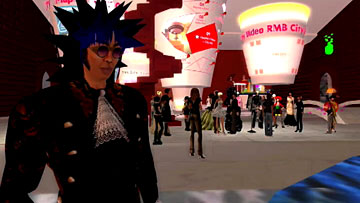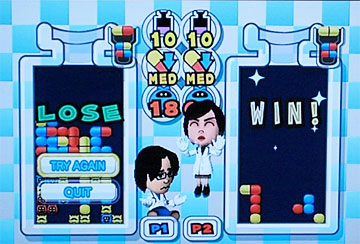
Cao Fei. Production still © Art21, Inc. 2009.
Online platforms have always been social environments. “Web 2.0” was not the birth of the social Web. Rather, it marked a point when Web technologists, recognizing the social nature of the Web, developed and deployed the tools to make social interaction easier for audiences of all ranges of technical familiarity, and to make social activity more prominent across Web publishing platforms.
Video games, too, have always been social experiences that were enhanced with addition of online components. From the early days of MUDs (Multi-User Dungeon), to their evolution into MMORPGs (Massively Multiplayer Online Role-Playing Game), to the online capabilities of the current generation of home video game consoles, online gaming removed the barrier of geographic location from the gaming experience and allowed gamers to always have a pool of other players readily available.
Following up on last week’s interview with Second Skin producer and writer, Victor Pineiro, for this second part, we talked about the online and offline social aspects of gaming culture, the joys of Mario Kart, and a few more odds-and-ends around the production of Second Skin.
[For readers in the New York City area, Second Skin screens tonight, tomorrow, and Sunday at The Tank in Hell’s Kitchen]
Jonathan Munar: There’s clearly an element of “social” in these virtual worlds. How would you describe social interaction in these games?
Victor Pineiro: I would argue, as controversial as it may sound, that gamers are actually more social than non-gamers, because being social is built in and facilitated by their activity of choice. Rather than socialize with a handful of people at a bar or someone’s house, or even dozens of people at the occasional party, MMO gamers are consistently socializing with hundreds of other gamers. Most gamers in virtual worlds belong to a guild—a group of gamers that are usually hundreds or thousands strong, and who communicate all the time through the game or online message boards. This is no longer limited to typing—a large portion of gamers use applications to voice-chat with fellow guildies, dozens on the same voice channel. So what you have is, in effect, these enormous conference calls, but tied to shared experiences all the gamers are having together. If you compare the typical gamer’s evening with the typical person, there’s no contest—even at our most social, we’re hardly interacting with dozens or even hundreds of people on a daily basis. For a gamer, that’s their usual Tuesday night.

Second Skin production still, 2008
JM: Do you see online social interaction as an enabler for offline social activity?
VP: Online social interaction is the ultimate enabler for offline social activity. Countless couples we’ve met and emailed with over the past few years have described how virtual worlds allowed them to find their perfect match. Then there are the guild meetings, where hundreds of gamers come together weekly, monthly, or annually to hang out with their online friends. The Syndicate, a 600+ person guild we follow in Second Skin, has weekly, monthly and annual meetings—and people fly in from all over the world to get together. These virtual worlds allow anyone to test the waters socially, get their feet wet, and then meet up with their new friends once they feel comfortable.
“The Fort Wayne Crew” (excerpt from Second Skin)
JM: You’re a gamer, but not an MMO player, right? What sets MMO’s apart from other online video games?
VP: It all boils down to this: MMOs don’t have a pause button. In other words, they are persistent worlds, whether you’re in them or not. When you play most video games, booting them up launches the world, and exiting them turns the world off—the universe of the game only exists for you to experience it. MMOs let you jump in and out of a virtual world, but once you’ve jumped out, there are thousands of people still “living” there—things are still happening while you’re away. Though you might not be there to experience the virtual sunrise after a long night, thousands of others are. And when you log on again, they might tell you that it was especially beautiful that night.
JM: You and I have played our share of Mario Kart, and I’ve already challenged Art21 guest blogger An Xiao to a race—that’s social, right?
VP: Society’s in the process of redefining the word “social”. Soon the field will be level, and face-to-face interaction won’t be regarded as any different than online interaction. So, yeah, Mario Kart is definitely social. As social as racing actual karts around a track (though with markedly less flying turtle shells).

Losing at Dr. Mario: The typical experience for my poor Mii
JM: In general, how do you feel that these platforms—MMOs, online games, and even online social networks—have affected society?
VP: I think the best way to answer this question is to borrow from our interview with Edward Castronova, the godfather of virtual world academia. Here is his take on the end of the world, thanks to MMOs.
“The most negative scenario I can see is that virtual worlds will become so alluring that we would stop being interested in physically connecting and we wouldn’t make any more children. So the end of the human race would look like…we’d have these environments where the physical body would be linked to the machine….We would say, “Look computer, I have to go to the bathroom. You could program your computer to control your character for 5 minutes. And then you would extend that. Even though the physical body may die, the computer can be told to run the character as the person ran him.
The computer would be given the AI to actually operate the character of the deceased person. So what’s going on in the virtual environment doesn’t look like it’s changing at all to us. You’re seeing the same players, but no one knows that the living person who played the character Galahad died three years ago. No new children are being born, so the final moment would be the last human being on earth is dying and he’s still wired up, but everyone else is actually dead. He’s the last person and doesn’t know it, and you can imagine his heart eventually stopping, and the computer continuing the routine. With full dignity the computer disposes the dead body and then begins to operate the avatar. Humanity is gone, but in the virtual world all that’s been seen is a computer-run little boy and the old man, and the old man closes his eyes and opens them again, but now he’s a computer, and the little boy’s a computer. And that’s the future of life on this earth. Its all artificial intelligence from that point forward.”
JM: I admired your use of online platforms to promote Second Skin before its premiere at SXSW 2008, ranging from targeted campaigns on social sites, to your own video diary at Austin. Did you find this method of promotion to be effective?
VP: We had a lot of fun blogging up a storm while filming the movie, and gradually building our online community until the movie’s premiere. We also found it extremely effective—we went from being mentioned on tiny MMO-centric blogs to NPR and Newsweek, all in the space of a few weeks, based on our growing online community and their ability to help spread word.
Now that the movie’s coming out in theaters and DVD, we’re gearing up for another round of video blogs, probably even wackier than the SXSW batch. We just like having fun with it—letting others know what it’s like to create a movie and let it out into the world. Juan Carlos, Peter and I have been throwing around ideas and figuring out ways to really let our community feel like they’re right beside us throughout the entire experience.
Video blogging: Second Skin @ SXSW, Part One
JM: Did you get to live out any fantasies by making this film?
VP: Oh God yes. Obviously, traveling the world and talking to fellow gamers is pretty much the best way to spend a year or two of one’s life. On top of that, the entire SXSW premiere experience was electrifying—from walking into that empty theater the day before the premiere, to seeing the line snake through the building before the show, to watching the movie with an audience for the first time. Also, we now have fun stories about being chased by the Chinese mafia, playing Guitar Hero with porn stars, and all sorts of other wacky things that happen to nomadic documentary filmmakers. Juan Carlos, the director, is about to live out his greatest fantasy—seeing his movie get a theatrical run in a bunch of cities!
What’s struck us the most, though, and it’s something we could have never expected, is the endless outpouring of support from family and friends. It’s really jaw-dropping to see so many people come together and support you through a very difficult (albeit exhilarating) process, time and again, over the course of three years.
Second Skin begins a limited theatrical run tonight in New York, and next week in Los Angeles, Austin, Boston, and Colorado Springs. The DVD will be released on August 25 (pre-orders are now available). More information is available on the film’s official Web site.




Pingback: What’s Cookin at the Art21 Blog: A Weekly Index | Art21 Blog